
Rabbit Anti-GCDFP15 antibody
PIP_HUMAN; PIP; Prolactin-inducible protein; Gross cystic disease fluid protein 15 (GCDFP-15); Prolactin-induced protein; Secretory actin-binding protein (SABP); gp17; GCDFP15; GPIP4; BRST-2;
View History [Clear]
Details
Product Name GCDFP15 Chinese Name 囊性组织液体蛋白15Recombinant rabbit monoclonal anti Alias PIP_HUMAN; PIP; Prolactin-inducible protein; Gross cystic disease fluid protein 15 (GCDFP-15); Prolactin-induced protein; Secretory actin-binding protein (SABP); gp17; GCDFP15; GPIP4; BRST-2; Research Area Tumour Cell biology immunology Immunogen Species Rabbit Clonality Monoclonal React Species (predicted: Human, ) Applications IHC-P=1:100-500 ICC=1:50-100 (Paraffin sections need antigen repair)
not yet tested in other applications.
optimal dilutions/concentrations should be determined by the end user.Theoretical molecular weight 13.5kDa Cellular localization Secretory protein Form Liquid Concentration 1mg/ml immunogen KLH conjugated synthetic peptide derived from human GCDGP15 Lsotype IgG Purification affinity purified by Protein A Buffer Solution 0.01M TBS(pH7.4) with 1% BSA, 0.03% Proclin300 and 50% Glycerol. Storage Shipped at 4℃. Store at -20 °C for one year. Avoid repeated freeze/thaw cycles. Attention This product as supplied is intended for research use only, not for use in human, therapeutic or diagnostic applications. PubMed PubMed Product Detail Gross cystic disease is a common premenopausal disorder in which gross cysts are the predominant pathologic lesion. It is characterized by production of a fluid secretion which accumulates in the breast cysts. Gross cystic disease fluid is a pathologic secretion from breast composed of several glycoproteins, including a unique 15 kDa monomer protein, GCDFP 15. The cells within the body that produce GCDFP 15 appear to be restricted primarily to those with apocrine function. Studies have found GCDFP 15 to be a highly specific and sensitive marker for breast cancer.
Subunit:
Monomer. Interacts with AZGP1.
Subcellular Location:
Secreted.
Tissue Specificity:
Expressed in pathological conditions of the mammary gland and in several exocrine tissues, such as the lacrimal, salivary, and sweat glands.
Similarity:
Belongs to the PIP family.
SWISS:
P12273
Gene ID:
5304
Database links:Entrez Gene: 5304 Human
SwissProt: P12273 Human
GCDFP15是一种15kDa的单链蛋白,常见于组织囊性病变的囊泡液中。GCDFP-15是一种高度特异和敏感的乳腺癌标志,可用于乳腺癌的鉴别诊断,与CK7和CK20联合使用,可以用于鉴别原发或继发乳腺外派杰氏病。Product Picture
Section type: Formalin fixed & Paraffin -embedded section
Retrieval method: High temperature and high pressure
Retrieval buffer: Tris/EDTA buffer, pH 9.0
Primary ab dilution: 1:1000
Primary ab incubation condition: 1 hour at room temperature
Counter stain: Hematoxylin
Comment: Color brown is the positive signal for SLM-54667R
Tissue: Human breast cancer
Section type: Formalin fixed & Paraffin -embedded section
Retrieval method: High temperature and high pressure
Retrieval buffer: Tris/EDTA buffer, pH 9.0
Primary ab dilution: 1:1000
Primary ab incubation condition: 1 hour at room temperature
Counter stain: Hematoxylin
Comment: Color brown is the positive signal for SLM-54667R
ICC staining of GCDFP 15 in Hela cells (green). Formalin fixed cells were permeabilized with 0.1% Triton X-100 in TBS for 10 minutes at room temperature and blocked with 1% Blocker BSA for 15 minutes at room temperature. Cells were probed with the primary antibody (SLM-54667R, 1/50) for 1 hour at room temperature, washed with PBS. Alexa Fluor®488 Goat anti-Rabbit IgG was used as the secondary antibody at 1/100 dilution. The nuclear counter stain is DAPI (blue).
References (0)
No References
Bought notes(bought amounts latest0)
No one bought this product
User Comment(Total0User Comment Num)
- No comment
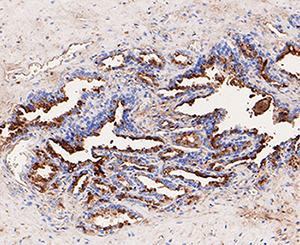
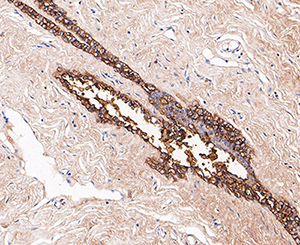
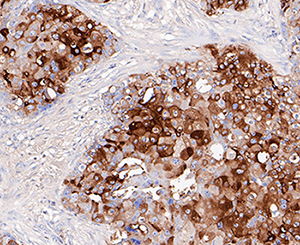
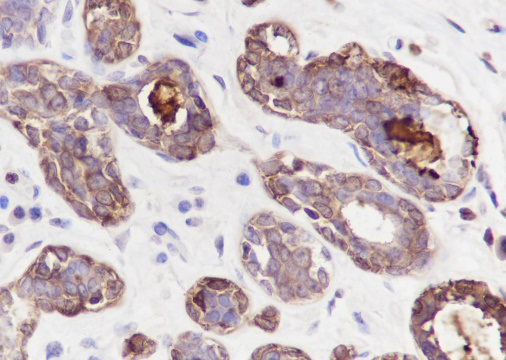
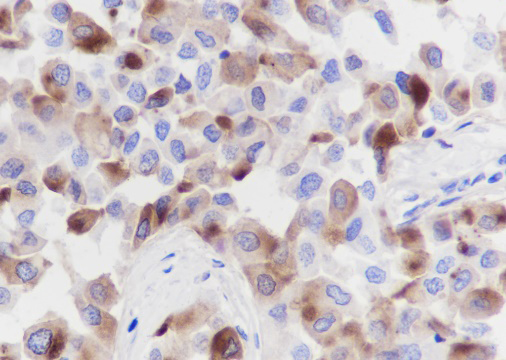
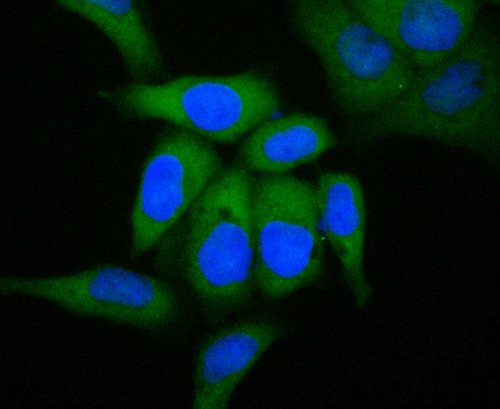


 +86 571 56623320
+86 571 56623320
 +86 18668110335
+86 18668110335

